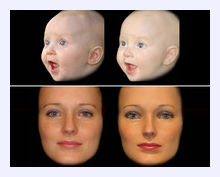
With its technologically advanced animated characters, the 2004 film The Polar Express was supposed to change moviemaking. Instead, it gave audiences the creeps. Reviewers dissed it as "the night of the living dead." Why didn't the audience perceive the characters as alive? Something, they said, was wrong with the eyes.
Now, a new study shows just how important the eyes really are when we judge whether a face is that of a living person or an inanimate object. And that ability, the researchers say, is key to our survival, enabling us to quickly determine whether the eyes we're looking at have a mind behind them.
"People want to see faces, and we're very adept at seeing faces everywhere: in clouds, a burnt piece of toast, even two dots and a line," says Christine Looser, a Ph.D. candidate in psychology at Dartmouth College and the study's lead author. "And it makes sense to be aware of faces," because they might be those of living, dangerous creatures, such as a grizzly bear. "But we also don't want to waste time on faces that aren't alive, that aren't attached to minds."
To find out where the tipping point lies between what we regard as animate and inanimate, Looser and her co-author and adviser Thalia Wheatley, a social neuroscientist also at Dartmouth, created a sequence of images of human and doll faces. They paired each doll face with a similar-looking human face and used morphing software to blend the two, ending up with a spectrum of pictures that ranged from fully human to part human-part doll to purely doll (watch videos here and here.)
Student volunteers looked at each picture and decided which were humans (that is, alive) and which were dolls. In another experiment 2 months later, the same participants looked at the same set of images, but they had to decide whether the faces had a mind.
The researchers found that the volunteers consistently selected as the dividing point those faces that were about two-thirds along the continuum, closer to the human end. These were also the faces deemed capable of thought. A separate experiment showed that nearly all participants looked at the eyes of the images - more than the mouth, nose, or skin - to determine if a face was actually that of a living being. The researchers report the findings in the current issue of Psychological Science.
The study "provides the tightest understanding to date of how individuals decide what is alive and what is not," says Jamil Zaki, a cognitive neuroscientist at Harvard University. Other studies have shown that people "would ascribe life to even simple shapes, such as squares and triangles," if they moved in a "lifelike way," Zaki says. "But this shows we are much more selective when it comes to seeing life in a face." Social psychologist Nicholas Epley of the University of Chicago in Illinois adds, "It shows there's some truth to that aphorism that the eyes are windows into the soul - although, what they've shown is that the eyes are really windows into our minds and whether or not we have one."



We shake right hands--to show we're unarmed, tip or take off our helmets indoors, and especially, look people in the eye while we're doing all these moves. Once you've looked the predator in the eye it's pretty easy to tell the difference--that is, if you know that there is a difference.